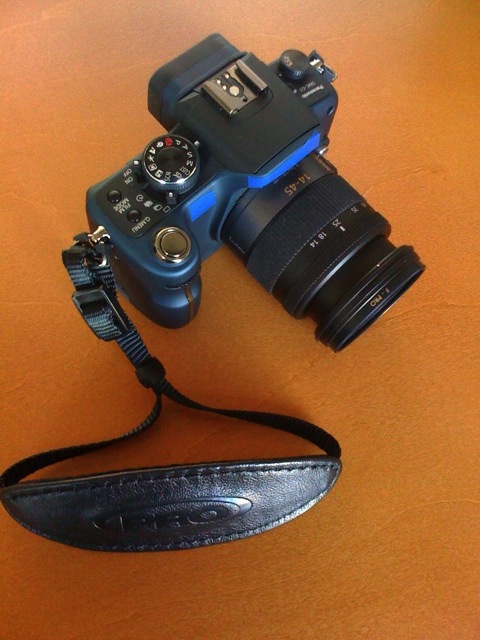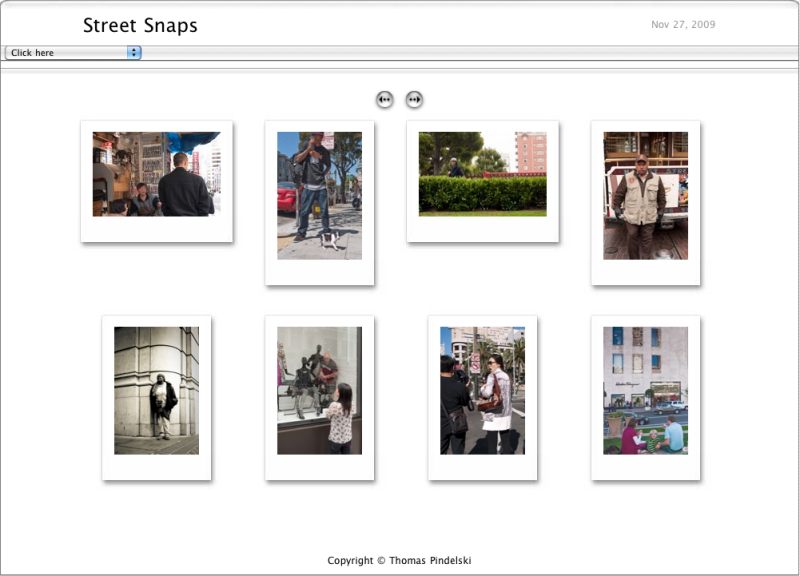A slam dunk.
It’s rather disingenuous to pronounce any camera as my ‘Camera of the Year’ as that implies I buy dozens of different ones and use each extensively. That’s obviously not the case. Not only do I have a day job, but I question how any photographer can really thoroughly wring out more than one or two cameras a year and lay claim to expertise on the subject.
If your thing is comparing the definition of brick walls and optical test charts for equipment, you need to go elsewhere. I am anything but an equipment tester or collector, and use my cameras to take pictures. When something more suitable comes along, I get it. Through 2008 I have been using – and continue to use – a Canon 5D (for big prints) and a Panasonic LX1 for small pockets.
No one camera can do everything, further casting doubt on the ‘Camera of the Year’ appellation. My primary interest is street photography and the dictates for my street camera are:
- Speed of response
- Choice of automation
- Small
- Light
- Low noise – the camera and its images
- A decent zoom lens which obviates lens changing
- Well enough made to survive the occasional knock or two
- A design that thinks outside the box
The result is a slam dunk and no surprise to frequent visitors here.

Camera of the Year – the Panasonic G1
Regular readers will know that the Panasonic G1 with its superb kit lens has become a firm favorite for street snaps here at chez Pindelski. I like to put money where my eye is, so to see a selection of snaps taken over past few months using my blue (!) G1 please click the picture below.

This camera, with its outstandingly small size and excellent electronic viewfinder, easily fulfills the above check list and, best of all, it works better than any street camera I have used over the past four decades, most of which were spent with M2 and M3 Leicas, the previous standard. I have taken four thousand pictures with mine and the only sign of wear is that a small bit of the blue rubberized covering has rubbed off on the lower left rear LCD hinge. Incidentally, I never use the LCD for taking pictures, just the EVF. Otherwise, all is well.
Could it be better? Of course. Scrap the faux prism hump and the flash unit and move the EVF off to the left of a flat top plate. Then drop all the silly settings (landscape, portrait, etc.), and make the front dial less susceptible to accidental movement. Move the ISO setting to a physical dial on the top left. A faster lens? Well, if Panny sees fit to add OIS shake reduction to the 20mm f/1.7 put me down for one. Meanwhile, I need all the OIS I can get so the 14-45mm OIS kit lens does fine. It just happens to be one of the best lenses I have ever used, given its design compromises, and I mostly use it at full aperture. Best of all, if you get mugged and lose the camera, your loss is modest if not painless. Mine cost under $650.
Processing? I have not tried the included software, simply importing all images into Lightroom 2 on my Mac. Whatever processing the camera and Lightroom perform, the distortion levels in the imported images are the lowest for a zoom lens I have encountered. I always use RAW and with Lightroom it’s as easy as using JPG with all the advantages RAW offers. If you decide to get a G1 and use Aperture, get Lightroom. Aperture still does not support the G1/GH1/GF1 which, given that the G1 has been out for some fifteen months now, probably means it never will. So unless you want to go through the time and space wasting process of converting all your files from RAW to DNG before import to Aperture, do yourself a favor and buy Lightroom, which will run far faster on your computer of choice and works as well in Windows as in OS X.
Some ages ago (30 months to be exact which is an age in the digital photography world) I wrote when ruminating about the future of lens design (paraphrased for the G1):
So, supposing I want a 24-105mm f/2. That would translate to a 12mm – 50mm lens on a small digital body which, fully corrected, would doubtless be a lot bulkier than the current kit lens. Now throw out the large front element, there to reduce vignetting. Get rid of several of the others there to confer minimal color fringing. And the hell with barrel distortion. Curvature of field and all those insurmountable problems with edge pixels and wide angle lenses? Nonsense. Just bow the edges of the sensor towards the lens as the focal length changes. Flexible sensors? Why not? Zoom? The next generation of sensors will obsolete optical zooming and do it all electronically. About time. Program around all of that with some smart software, fix the image on the fly when saving (or even when viewing if it’s that horrible to look at) and your 24-105mm f/2 zoom is now 1″ in diameter and 2″ long. Wow! So we gradually return to the days of the Box Brownie with its miniscule single meniscus lens, but with an image readily enlarged 12 times or more.
And who will be the genius designing these new ‘lenses’? It won’t be a god the likes of Max Berek or Walter Mandler in Wetzlar. It will be some kid who is really sharp at coding who happens to like a superb picture from the one ounce piece of plastic passing for a lens attached to his camera. The great days of optics are yet to come and their designs will emanate from the keyboard of some unknown master even now getting his lips around the teat on that plastic milk bottle.”
Panasonic and Adobe have opened that door with their software processing for the G1. The future is exciting and the G1 is on the cusp of that future. One of the advertising slogans for early 35mm film cameras was “Small camera, large picture”. The rangefinder Leica improved on that with robust engineering which could sustain extended hard use. I believe that Micro-4/3rds format cameras like the Panasonic G1 update that concept for the digital age and enhance the flexibility and versatility of those Leicas of old by an order of magnitude.
If street candids are your thing and you like your equipment responsive, automated, small and exceptionally unobtrusive with a wonderful kit lens, I recommend a G1 without qualification. For the jaded street snapper who wants the best there is for relatively little money, this is one camera for the short list. It is simply a breath of fresh air and will get your creative juices flowing once more.